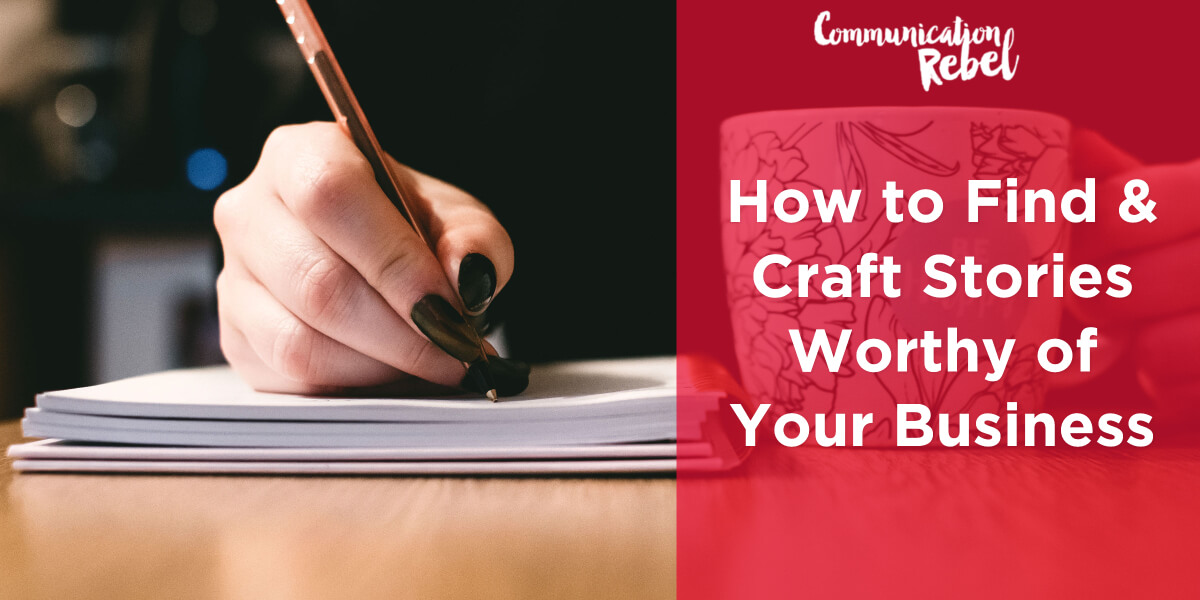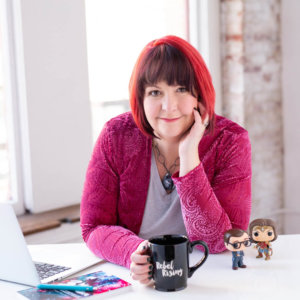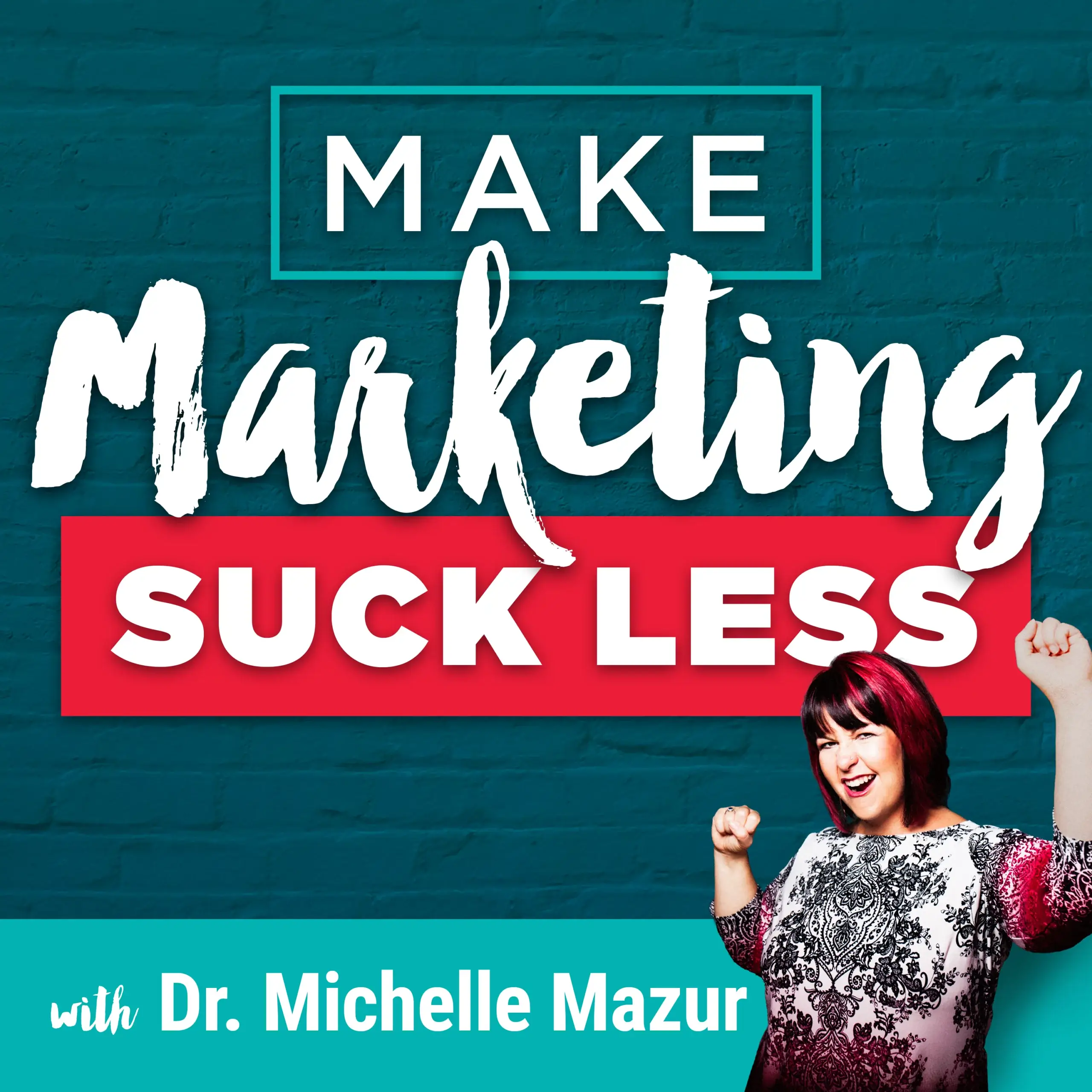Make Marketing Suck Less
How to Find & Craft Stories Worthy of Your Business
By Michelle Mazur > March 17, 2020
Filed Under Podcast

In the last episode of the podcast, we talked about the three signature stories that your business needs to turn strangers into clients, connection stories, reason to believe stories, and, elevated social proof stories. So, if you haven't listened to last week's episode of the pod, you'll want to do that before diving into this week's.
Now that you know allllll about the different types of stories, you may be wondering how you actually find those stories. I know that this is a common question my clients have when it comes to supporting their own 3 Word Rebellions, and it is even an obstacle that I still struggle with time to time.
That was until I came across the book Storyworthy by Matthew Dicks. In his book, Matthew lays out how to find stories from your own life that can be used to connect to your audience to help convert strangers to paying clients:
- At the end of each day, set apart a time for reflection. Find your five second transformation moment for that day.
- Use the first, best, last, and worst technique.
Okay, so maybe you have some topics floating around your head now, but how do you actually write those stories to make them enticing? Tune into the podcast or read through the transcript below because that's exactly what I'm covering.
Remember, storytelling is an art. It needs practice, a well crafted story that emotionally connects that is persuasive and that moves your audience from strangers to clients takes some work, but man, it is worth it.
Table of Contents
- 1 So I'm going to share some of those exercises from Matthew Dick's book, Storyworthy.
- 2 So let's begin with how you find stories to tell.
- 3 Another great way to find stories is called first, last, best, and worst.
- 4 So those are two ways to start finding stories. Now that you found them, how do you start crafting them?
LISTEN IN OR READ THROUGH THE TRANSCRIPT BELOW
Resources mentioned in this episode
Signature Stories Your Business Needs to Tell to Turn Strangers Into Clients
Hey rebels. In the
last episode of the podcast, we talked about the three signature stories that your business needs to turn strangers into clients, connection stories, reason to believe stories, and, elevated social proof stories. Now, if you haven't listened to last week's episode of the pod, do not pass go. Do not collect $200 and go back and listen to that one first.
This episode will be way, way more useful and helpful to your business if you do that because in this episode, we're going to talk more about how to find and craft those three kinds of stories. Okay. Do you swear that you have listened to last week's episode?
All right. I believe you, let’s do this.
When I am working with clients in the 3 Word Rebellion messaging intensive, one of th biggest things they struggle with in the whole process is not discovering their 3 Word Rebellion, not figuring out their client journey, not figuring out their marketing plan or how they're going to launch this new message into the world, it's finding these signature stories.
They love all the free writing they get to do, but when it comes to actually supporting that client journey and supporting their 3 Word Rebellion with stories, it's like bam, they hit a wall with it. And it's funny because we, human beings are supposedly these storytelling machines, right?
And as I'm always iterating the process I use with my clients because I'm always looking for ways to make it more enjoyable, more effective, more efficient. I keep tweaking the process around signature storytelling, and I'm always up against this difficulty. And then I finally read this book, and it's a book Brooke Castillo talked about on the
Life Coach School Podcast, and it's a book called
Storyworthy by Matthew Dicks.
This guy has one 36
Moth Story Slams and he's a five time grand slam champion. So when it comes to story, he knows what he's talking about. And I picked up this book and it explained why my clients were always hitting a wall when it came to storytelling. Because he spends half the book talking about how people struggle to find stories and giving different exercises for how to find your story.
So halleluja, I was finally given some solution and some relief for why this was always such a sticky point in my process. So if you've ever struggled with figuring out what your story is, how to tell it in your business, how to tell it, well, just know that you're not alone.
So I'm going to share some of those exercises from Matthew Dick's book, Storyworthy.
I highly recommend that you check it out on
Amazon. It's not an affiliate link. I'm just a really big fan of this book and so along with that. I'll be giving you some tips and tricks from Matthew's book, from my own toolbox, and some unexpected places for how to craft your story.
So you don't want to miss this episode because it's really going to help you tell your business story better.
So let's begin with how you find stories to tell.
The first thing we have to accept is that stories happen to us all the time and we have to start training ourselves to pay attention to find the stories. Yeah, because most of the time we just let our lives pass us by. And the thing we don't want, and I talked about this a little bit in the last episode, is we don't want big sweeping stories.
In fact, Matthew argues in his book that the big stories of life and death experiences, those are the hardest stories to tell, and I've long been an advocate and I wrote about this when I was still working in as a public speaking coach, is that we need to find small moment stories, the everyday stories that people just can relate to.
And Matthew Dicks calls these a five second moment. He says in every story you want to find a five second moment. That is a moment of true transformation. So for me, when I tell the connection story of how I got my first client, my five second moment is the moment that I, with a trembling hand, pushed publish on a blog post that scared the crap out of me.
When my client shared her 3 Word Rebellion with a prospective client for the first time, it was that moment after she shared it where she saw the client's face light up, that she knew her new message would work. It's a small moment. That's what you're looking for. It's not this rags to riches moment. It's not a life or death experience. It's not a traumatic story. It's a small moment. It's a five second moment.
So how do you find five second moments? Matthew has a great
Ted Talk on this, it's called Homework For Life, and it is a daily habit that will help you start looking for stories.
So, basically the daily habit is at the end of the day you reflect on the day and you just try to find a moment of your day that could make a great story. And in the book he talks about some questions you can ask yourself. If I had to tell a five minute story on stage about something that took place over the course of today, what would it be?
As benign, as inconsequential, as my day has been, what is the most story worthy moment of my day? So just thinking back on your day and finding just a little something, something that you could tell a story around. And then writing a sentence or two down about that moment, and that's all it takes every single day.
So this is going to take you two to three minutes, but it will get you into the habit of looking for stories and also it gets you in the habit of documenting your life every single day. And so I think that's a pretty cool side effect of this. So yes, it can help you build your business and figure out good stories to tell from your business. It also will help you document your life.
Another great way to find stories is called first, last, best, and worst.
And this is the one I actually took from Matthew's book with credit. I give this to my clients to do as a warm up for when they're finding stories to support their client journey and their 3 Word Rebellion. I give my clients some random topics and they recall a moment around the random topic, and it may or may not produce a story worthy moment, but at least it gives them a state of recall.
So let me give you an example. Let's say I give you the random topic of meals. So you would want to think about your first meal, the last meal you had, the best meal you had, and the worst meal you had. So the first meal I had that I can remember was spaghetti. And why I remember it is because I was choking on it, and my aunt Sandy put her hand down my throat and pulled up the spaghetti noodle.
I remember that the last meal I had was a turkey sandwich. That's not gonna make a great story. The best meal I had was at a Gordon Ramsey restaurant in London, and I met the maitre’d who used to be on Hell's Kitchen, and since I was alone, he spent a lot of time with me and he chatted with me about being on the show. That was actually pretty cool.
The worst meal I ever had was at Ivers. And I had clam chowder and it was actually my podcast producer’s birthday and I had ended up with food poisoning. So yeah, you can see how these are like starting to help me recall moments.
So if you're trying to think about clients that you've had or you know, moments from your business, you can think about the first client you had, the last client, you had the best client, you had the worst client you had and recall stories that way. Or the first speaking gig you had the last speaking gig, you had the best speaking gig, you had the worst speaking gig you had and recall stories that way.
So those are two ways to start finding stories. Now that you found them, how do you start crafting them?
Well, Matthew Dicks recommends that you, for every story that you find and that you want to tell, that the first thing you do is that you find that five second moment of transformation because that will help you figure out how to tell the rest of the story.
So whether it's that moment of your shaking hand pushing publish on a blog post or the moment that your client has that breakthrough, that changes everything. What is that exact moment where everything changes? Because from there you can build the story around that moment of trance transformation.
The second tip is how to begin a story, because beginning a story is difficult.
Most people start with, “let me tell you a story.” No, don't say that. Just start telling us a story and in Storyworthy he also suggests that don't start by telling setting expectations like, “Hey, this is absolutely hysterical. You're going to love this”. No, just, no, no, no, no. But I love the tip that he gives because he talks about beginning with forward momentum, like entering into a room or, you know, I opened the door and I walked out onto the street with a goldfish in my hand.
Right? Like it's starting with some kind of movement and when we're moving someplace, that gets another person's brain involved, so you can see how storytelling and crafting your business story can take a little bit of time because we don't, we don't usually do this. We just kind of list things off when we think we're telling a story.
All right. Another key thing in a story is that we have to raise the stakes, right? Because I think the worst kind of stories are vacation stories. If somebody comes back from vacation and you ask them like, oh, how was your vacation? What do they do? They usually list the top things that they did right? They're like, oh, it was great. We went to Hawaii and we went to this beach and we went to a luau and we went swimming with the manta rays and we went to another beach and we went to the volcano, blah, blah. And it's boring because nothing's happening. It's just a list.
So with a story, there has to be some tension, there has to be some drama, something needs to be on the line. So in Storyworthy, he calls this raising the stakes. So what is on the line in your story? So when I'm telling the story of getting my first client, and I'm talking about publishing that blog post that scares me, I can raise the stakes by saying to myself, oh my gosh, I'm going to publish this blog post. I'm going to get so much hate mail. I'm going to lose all the readers I have. Everybody's going to think I'm a horrible person for saying the things that I have. I'm never gonna go anywhere with this blog. I can raise the stakes in that and you know, like my life is over.
This is never going to go anywhere. Or even with my clients' stories, like my client testing out a new message, like, oh my gosh, she's going to say these words and they're going to just laugh her out of the room. Or looking at. Confused and like, why would I ever want your 3 Word Rebellion?
And the final tip I have for you for crafting a story is that at the end of the story, and I've talked about this before, is giving your audience a story turnaround, and this is what's the universal truth of your story?
Don't leave the audience guessing why they listened to your story. I remember once I went to an event and there was a speaker who started her speech by telling us about her cancer, and it was a somewhat gripping story, but the whole time in my head I'm like, why are you telling us this? You're supposed to be talking about business development.
Why are you talking to us about cancer and your health and why? Why, why? And I kept asking that question and she never really answered it. She could have easily done it. She could have easily said, you know, and oh my gosh I was so grateful that I had such a huge focus on business development and had these systems in place because my business kept running and kept supporting my family through this cancer scare.
That would have been a story turned around. I would have been like, oh, that's why she's telling us. But there is a moral to every story, and as a storyteller for your business, you need to pull that out for the audience. It would be lovely if they could reach that conclusion on their own.
I have a recommendation for someone who does this particularly well, that is someone who is not related to the business world at all, but one of my new favorite podcasts is
Levar Burton Reads, and if you're like, isn't that Jordy LA forge from star Trek the next generation? Or you're like. Isn't that the reading rainbow guy? Yes. Yes it is. And he has a podcast where he reads short stories and he's brilliant at reading the story. So this will help you get better at delivering stories if you're delivering them on stage or on podcasts yourself. But what I love is that at the end of every story he tells, he brings the story back to a universal truth.
I love that he gives it some kind of interpretation and some kind of meaning. Check that podcast out, Levar Burton Reads, he does a lot of speculative fiction, so some, which is pretty much like science fiction, but it's just beautifully done, beautifully produced. The stories are great, but really listen to how at the end of the story, he gives it context. He gives it meaning and he pulls out the universal truth.
Think about how you can do that for your connection story? How can you do that for your reason to believe story? How can you do that for your elevated social proof story? Because my friends, storytelling is an art. It needs practice, a well crafted story that emotionally connects that is persuasive and that moves your audience from strangers to clients. It does take some work, but man, it is worth it.
So go forth. Find those stories, craft those stories, and use them. Use them on your about page in your speaking, on your webinar bars, in your social media, in your blog posts content, because it will support your audience on their journey to, yes.
Sign up to receive email updates
Enter your name and email address below and I'll send you periodic updates about the podcast.
Create Your One-of-a-Kind Message
Your 3 Word Rebellion is the Key to Growing Your Business & Impact






